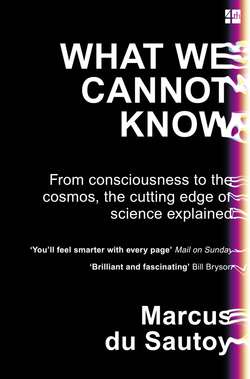Читать книгу What We Cannot Know: Explorations at the Edge of Knowledge - Marcus Sautoy du - Страница 39
ON THE EDGE OF CHAOS
ОглавлениеNewton and his mathematics gave me a feeling that I could know the future, that I could shortcut the wait for it to become the present. The number of times I have heard Laplace’s quote about ultimately being able to know everything thanks to the equations of motion is testament to a general feeling among scientists that the universe is theoretically knowable.
The mathematics of the twentieth century revealed that theory doesn’t necessarily translate into practice. Even if Laplace is correct in his statement that complete knowledge of the current state of the universe together with the equations of mathematics should lead to complete knowledge of the future, I will never have access to that complete knowledge. The shocking revelation of twentieth-century chaos theory is that even an approximation to that knowledge won’t help. The divergent paths of the chaotic billiard table mean that since we can never know which path we are on, our future is not predictable.
Chaos theory implies that there are things we can never know. The mathematics in which I had placed so much faith to give me complete knowledge has revealed the opposite. But it is not entirely hopeless. Many times the equations are not sensitive to small changes and hence give me access to predictions about the future. After all, this is how we landed a spaceship on a passing comet. Not only that: as Bob May’s work illustrates, the mathematics can even help me to know when I can’t know.
But a discovery at the end of the twentieth century even questions Laplace’s basic tenet of the theoretical predictability of the future. In the early 1990s a PhD student by the name of Zhihong Xia proved that there is a way to configure five planets such that when you let them go, the combined gravitational pull causes one of the planets to fly off and reach an infinite speed in a finite amount of time. No planets collide, but still the equations have built into them this catastrophic outcome for the residents of the unlucky planet. The equations are unable to make any prediction of what happens beyond this point in time.
Xia’s discovery is a fundamental challenge to Laplace’s view that Newton’s equations imply that we can know the future if we have complete knowledge of the present, because there is no prediction even within Newton’s equations for what happens next for that unlucky planet once it hits infinite speed. The theory hits a singularity at this point, beyond which prediction makes no sense. As we shall see in later Edges, considerations of relativity will limit the physical realization of this singularity since the unlucky planet will eventually hit the cosmic speed limit of the speed of light, at which point Newton’s theory is revealed to be an approximation of reality. But it nevertheless reveals that equations aren’t enough to know the future.
It is striking to listen to Laplace on his deathbed. As he sees his own singularity heading towards him with only a finite amount of time to go, he too admits: ‘What we know is little, and what we are ignorant of is immense.’ The twentieth century revealed that, even if we know a lot, our ignorance will remain immense.
But it turns out that it is isn’t just the outward behaviour of planets and dice that is unknowable. Probing deep inside my casino dice reveals another challenge to Laplace’s belief in a clockwork deterministic universe. When scientists started to look inside the dice to understand what it is made of, they discovered that knowing the position and the movement of the particles that make up the dice may not even be theoretically possible. As I shall discover in the next two Edges, there might indeed be a game of dice at work that controls the behaviour of the very particles that make up my red Las Vegas cube.
